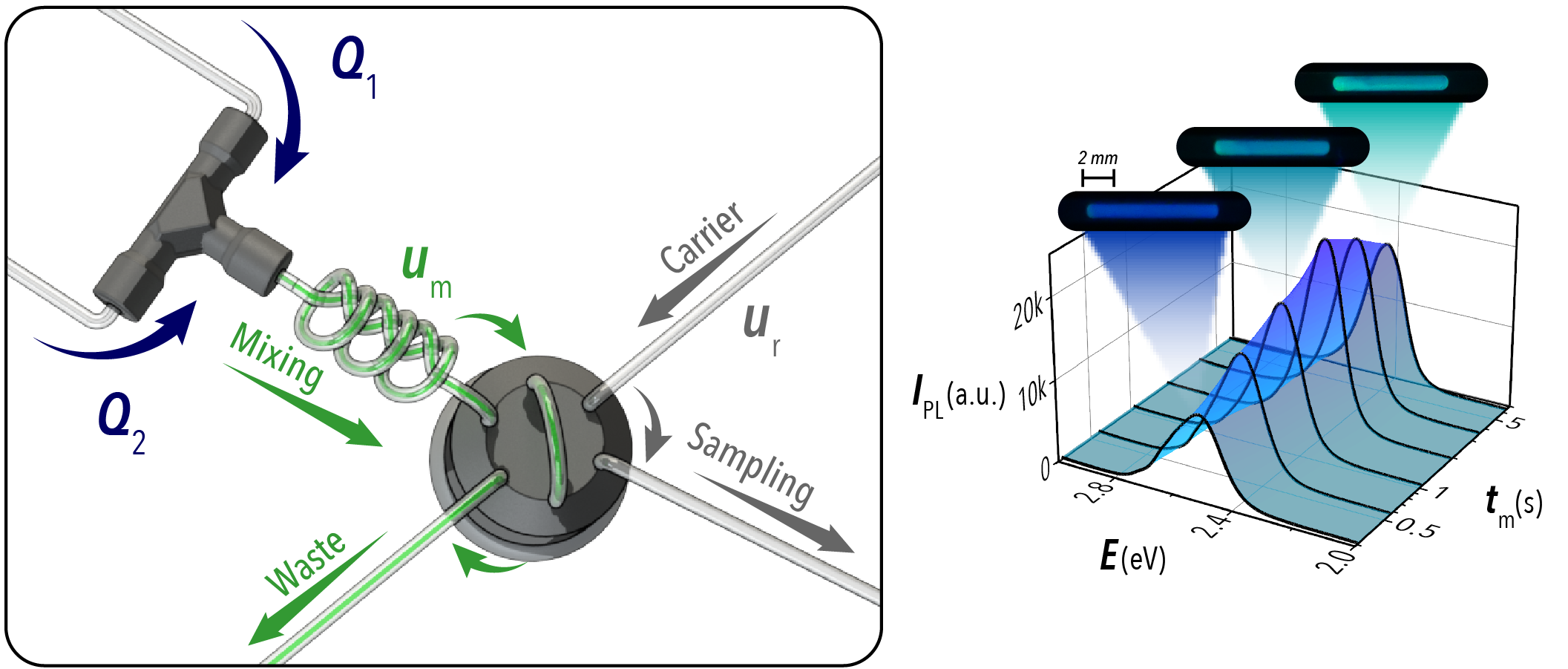(200f) Modular Fluidic Microreactor for Fully Decoupled Precursor Mixing and Reaction Times in Mechanistic Studies of Metal Halide Perovskite Quantum Dot Synthesis
AIChE Annual Meeting
2020
2020 Virtual AIChE Annual Meeting
Particle Technology Forum
Nanomaterials for Energy and Environmental Application
Tuesday, November 17, 2020 - 9:15am to 9:30am
However, as a property inherent to continuous flow processes, reaction time and mixing rates are strongly coupled to the total fluid velocity moving along the flow direction. In this work, we have developed a microscale fluidic microprocessor strategy which can independently control mixing times from 53 ms to 7.3 s with an arbitrarily long residence (i.e., reaction) time. This microscale flow synthesis approach was accomplished by first developing and analyzing a fluoropolymer-based passive micromixer developed using commercially available tubing. We then integrate the passive micromixer module with an automated, material-efficient fluidic sampling module, which allows for two independent flow rates to run simultaneously within the platform. Utilizing the developed modular fluidic platform, “samples†with a specific chemical formulation are pulled from the mixing line and passed to the reaction/analysis line where they continue to react after forming homogenous reactive phase plugs. These plugs move through the flow reactor channel towards a spectral monitoring module for in-situ UV-Vis absorption and photoluminescence measurements.
In the next step, we applied the developed modular flow synthesis platform towards the room-temperature synthesis of cesium-lead-bromide perovskite quantum dots [6] and unveiled a mechanistic understanding of the quantum dot growth process through time-resolved spectral sampling. We then conducted a full compositional analysis coupled with variations in the precursor mixing time to attain highly tunable emission colors as well as quantum dot size distributions, quantum yields, reaction yields, and numbers of quantum dots formed. These experiments were coupled with a first principle mesoscopic kinetic Monte Carlo simulation to provide further insights into the mechanism behind the ligand-assisted reprecipitation process at early time scales. The strategies and models developed in this work offer a greater understanding of controlled synthesis of perovskite quantum dots with fast formation kinetics.
References
[1] Q. A. Akkerman, G. Rainò, M. V. Kovalenko, L. Manna, Nat. Mater. 2018, 17, 394.
[2] K. Abdelâ€Latif, R. W. Epps, C. B. Kerr, C. M. Papa, F. N. Castellano, M. Abolhasani, Adv. Funct. Mater. 2019, 29, 1900712.
[3] R. W. Epps, K. C. Felton, C. W. Coley, M. Abolhasani, Lab Chip 2017, 17, 4040.
[4] L. Bezinge, R. M. Maceiczyk, I. Lignos, M. V. Kovalenko, A. J. deMello, ACS Appl. Mater. Interfaces 2018, 10, 18869.
[5] S. Marre, K. F. Jensen, Chem. Soc. Rev. 2010, 39, 1183.
[6] S. Wei, Y. Yang, X. Kang, L. Wang, L. Huang, D. Pan, Chem. Comm. 2016, 52, 7265.
